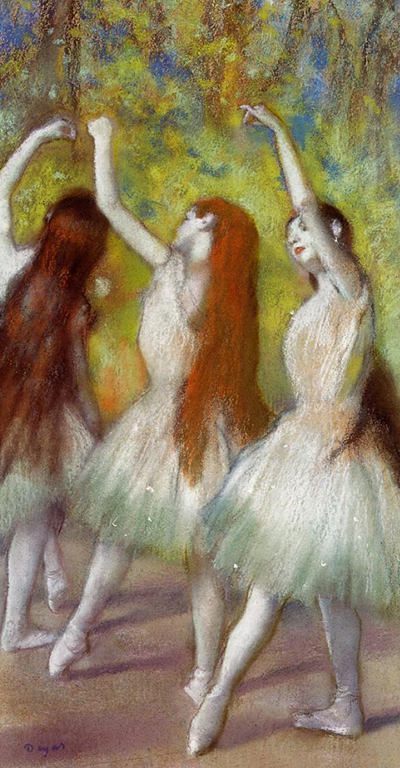Edgar Degas enters a new realm of art creation as he produces the captivating piece, Dancers In Green.
The stunning artwork illustrates three ballerinas on stage in a graceful movement. These three women stand near one another as they hold their left arm above their heads. Edgar Degas created this genre painting with no specific focal point in mind. Instead of bringing the viewer's attention to a specific place, the artist let the artwork speak for itself. Edgar Degas is commonly known for using different colours, techniques, and placement to capture the viewer's gaze and bring it towards one particular part. This is essentially showcased within his work Three Ballet Dancers, Dancer In Her Dressing Room, Dancers Pink And Green, and Dancers On Set. All of these brilliant pieces focus on showcasing a certain character that Degas felt was more significant than the others.
Dancers In Green on the other hand refrains from showcasing a particular ballerina, and instead prefers to show them as a whole. The viewer can equally analyze each, alongside other items throughout the painting. The Parisian artist is well known for using form and perspective throughout his work. He adored using a side profile to get a different glimpse of his artwork. This is significantly evident within this pastel piece as it's slightly to the side. It could almost be imagined that Degas was standing at the corner of the stage and painting this masterpiece while the dancers's froze in time. The most critical element of the piece is the patterns illustrated by the woman's body. The ballerinas are following their leader to the left and copying every movement that she does. The first movement is shown by the woman on the right. She points her left foot towards the audience while looking at them.
Later, the ballerina in the middle points her foot towards off stage with her perspective in the same direction. Finally, the leader points her foot towards the background of the stage looking into it. Their composed movements create a distinct pattern that the viewer can pick up. The viewer can easily imagine the exact way in which the ballerinas are moving. The other significant element that is immensely different from the artist's other work is the long flowing hair of the women. Rather than having their hair neatly tied in a bun with a bow, their ginger coloured hair freely flows towards the back of their dress. Since the ballerinas let their hair flow loose, it is most likely that their performance is incredibly sensual and soft. The three ballerinas are dressed in a white costume with pastel hues of tangerine and mint. The dress falls beneath the woman's arms as the peachy-salmon shade covers the fabric. Towards the bottom of the skirt the bright mint colour is presented. An ombrŽ effect is alive throughout the different colours on the dress.
All three ballerinas wear white tights with silk ballet flats that tie upwards as a ribbon. These simple details greatly distinguish themselves from the rest of the artist's artwork. It is evident that this piece has a different touch that the artist's work usually does. The other stunning aspect of the piece is the bright background that fills the stage. Rich salad greens dominate the background with specs of blue and yellow. Deep linear lines fill the top of the wall in an illusion of trees. This natural background perfectly resembles the attire of the majestic ballerinas.




